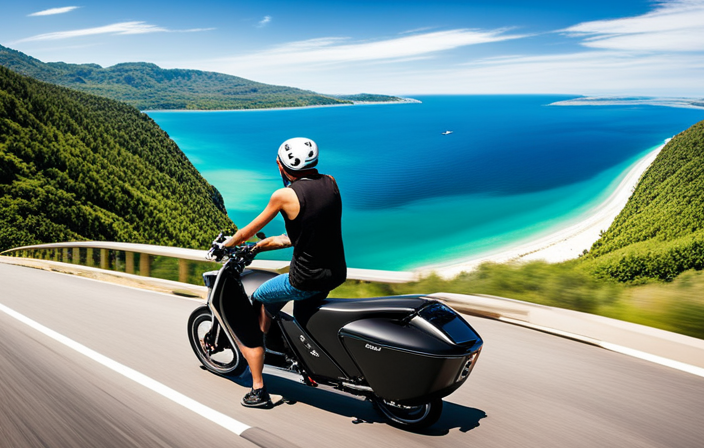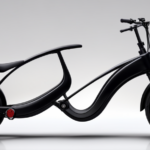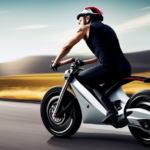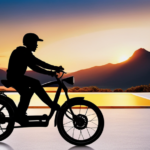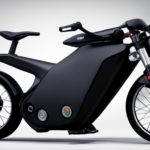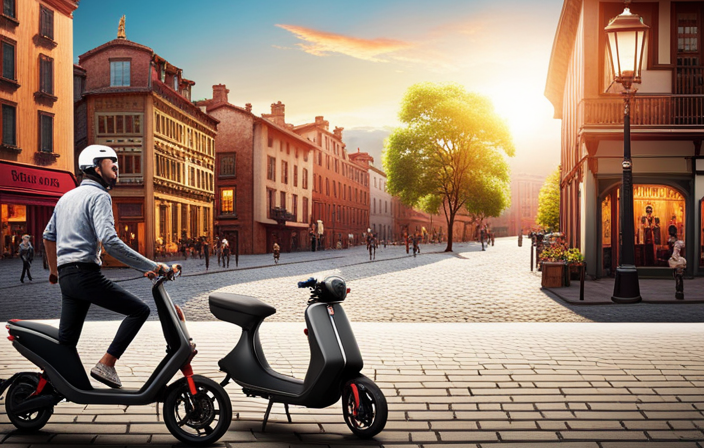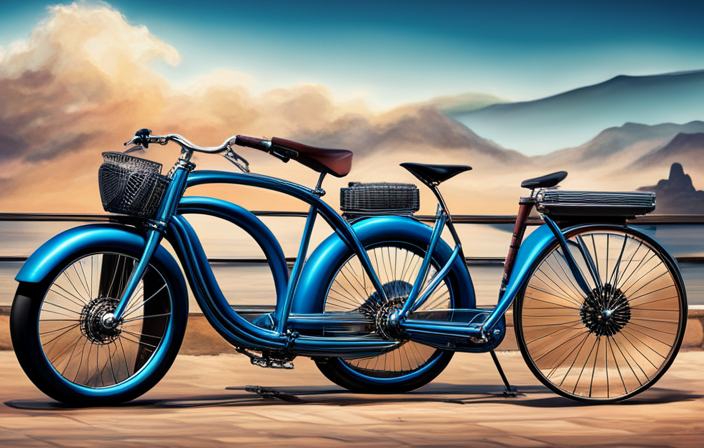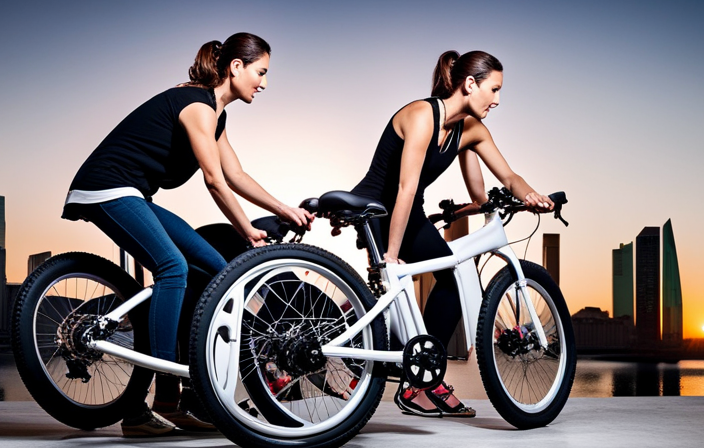Have you ever wondered how far you can go on a 48v 1000w electric assist bike? Strap on your helmet and get ready to explore the limits of your electric ride.
In this article, we will delve into the technicalities and factors that determine your electric bike’s range. From battery capacity and terrain evaluation to rider weight and pedal assist, we will leave no stone unturned.
So, get ready to ride longer and go further on your 48v 1000w electric assist bike.
Key Takeaways
- Battery technology and motor efficiency are the key factors determining the range of a 48V 1000W electric assist bike.
- Higher capacity batteries and batteries with higher energy density provide longer range.
- More efficient motors offer longer range by converting electrical energy into mechanical power more efficiently.
- Monitoring battery usage and adjusting riding style can help conserve battery power and maximize the distance that can be covered.
Understanding Battery Capacity
You can determine how far you can ride on a 48v 1000w electric assist bike by understanding the battery capacity. The battery lifespan directly affects the distance you can travel on a single charge.
A 48v battery typically has a capacity ranging from 10Ah to 20Ah. This means that the battery can provide a certain amount of power for a specified duration. The higher the battery capacity, the longer you can ride without needing to recharge.
Additionally, the charging time is an important factor to consider. Most 48v batteries take around 4-6 hours to fully charge, although this can vary depending on the specific model and charger.
It’s important to take these factors into account when planning your rides to ensure you have enough power to reach your destination.
Evaluating Terrain and Its Impact on Range
When evaluating terrain, the impact it has on range becomes apparent. One key factor to consider is evaluating speed and its impact on range. Riding at higher speeds requires more power from the electric assist bike, which can decrease the overall range. The aerodynamic drag increases exponentially as speed increases, resulting in higher power consumption. It is important to find a balance between speed and range to optimize the efficiency of the battery.
Additionally, analyzing weather conditions and their effect on distance is crucial. Riding against strong headwinds or in extreme temperatures can significantly impact the range of the electric assist bike. Wind resistance and increased rolling resistance due to wet or icy surfaces can also reduce the overall distance that can be covered on a single charge.
Therefore, when evaluating terrain, it is important to consider the impact of speed and weather conditions on range.
Considering Rider Weight and Its Effect on Distance
Considering the rider’s weight can have an effect on the distance that can be covered. Heavier riders require more power to propel the bike, which can result in decreased battery life and a shorter overall distance. To illustrate this impact, let’s examine a table showcasing the approximate range of a 48V 1000W electric assist bike based on different rider weights:
| Rider Weight (lbs) | Estimated Range (miles) |
|---|---|
| 150 | 40 |
| 180 | 35 |
| 210 | 30 |
| 240 | 25 |
| 270 | 20 |
As the rider weight increases, there is a noticeable decrease in the estimated range. This emphasizes the importance of considering rider weight when determining how far one can ride on an electric assist bike. Additionally, to preserve battery life, it is advisable for heavier riders to utilize different power assist levels or adjust their riding style to optimize efficiency.
Maximizing Efficiency with Pedal Assist
To maximize efficiency, it’s important to optimize pedal assist while riding an e-bike. Here are three techniques that can help you get the most out of your ride:
-
Cadence: Maintaining a consistent and efficient cadence is key. Aim for a pedaling speed of around 60-80 revolutions per minute (RPM). This will ensure that you’re utilizing the pedal assist system effectively without straining your muscles.
-
Gear Selection: Choosing the right gear can make a significant difference in your energy expenditure. Start in a lower gear and gradually shift to higher gears as you gain momentum. This will allow you to maintain a steady pace and reduce unnecessary strain on the motor and battery.
-
Battery Maintenance: Proper battery maintenance is crucial for maximizing efficiency. Keep your battery charged between 20-80% for optimal performance and longevity. Avoid extreme temperature conditions and store the battery in a cool and dry place when not in use.
By implementing these pedaling techniques and taking good care of your battery, you can ensure a longer and more efficient ride on your 48V 1000W electric assist bike.
The Role of Motor Power in Range
You can maximize the range of your e-bike by understanding the role of motor power.
Motor power is a critical factor that directly impacts the range of an electric bike. Higher motor power generally means greater acceleration and higher top speeds, but it also consumes more energy.
To estimate the range of your e-bike, you need to consider the power rating of your motor. A 48V 1000W electric assist bike has a relatively powerful motor, which allows for faster speeds and greater assistance while pedaling. However, it also means that the battery will drain faster, resulting in a shorter range compared to lower-powered motors.
To get the most out of your e-bike’s range, it is essential to find a balance between motor power and battery capacity that suits your riding style and needs.
Factors That Affect Range on Electric Bikes
One factor that can affect the range of your e-bike is the terrain you are riding on. Evaluating the weather conditions is also crucial in determining the range of your electric bike. Riding against strong headwinds or in heavy rain can significantly decrease the battery life. Additionally, the impact of tire pressure should not be underestimated. Maintaining the correct tire pressure is important as underinflated tires can increase rolling resistance, leading to a decrease in range. On the other hand, overinflated tires can result in a harsh ride and reduce traction, affecting the overall performance of the bike. To better understand the relationship between these factors and the range of your e-bike, refer to the table below:
| Terrain | Weather Conditions | Tire Pressure |
|---|---|---|
| Hilly | Windy/Rainy | Low |
| Flat | Sunny | Medium |
| Mixed | Mild | High |
By considering these factors, you can make informed decisions to optimize the range of your electric assist bike.
Tips for Extending Your Electric Bike’s Range
If you want to go further on your e-bike, try implementing these tips to extend its range.
Evaluating battery performance is crucial for maximizing your electric bike’s range. Start by regularly checking the battery’s voltage and capacity to ensure it is performing at its best. Additionally, consider investing in a high-quality battery with a higher voltage and capacity to increase your bike’s range.
When it comes to charging your electric bike, follow these tips to optimize its range. First, charge your battery fully before every ride to ensure you start with maximum power. Second, avoid overcharging the battery as it can lead to decreased performance and reduced lifespan. Lastly, charge your battery at moderate temperatures, avoiding extreme hot or cold conditions, as it can negatively affect the battery’s overall performance and range.
By evaluating battery performance and following these tips for charging your electric bike, you can extend its range and enjoy longer rides.
Real-Life Range Examples on a 48v 1000w Electric Assist Bike
To gauge the actual distance you can travel on a 48v 1000w e-bike, take a look at these real-life range examples.
Battery maintenance plays a crucial role in determining how far you can ride on your electric assist bike. Regularly check the battery’s voltage and ensure it is properly charged. It is recommended to charge the battery after each ride to maintain its optimal performance.
Additionally, consider the charging options available to you. Some e-bikes have removable batteries that can be charged separately, allowing you to have spare batteries for longer rides. Furthermore, using a higher voltage charger can significantly reduce the charging time.
By properly maintaining your battery and utilizing efficient charging options, you can maximize the range of your 48v 1000w e-bike and enjoy longer rides without worrying about running out of power.
Comparing Range on Different Electric Bike Models
After exploring real-life range examples on a 48v 1000w electric assist bike, it is now important to delve into comparing range on different electric bike models.
When it comes to electric bikes, the range is heavily influenced by battery technology and motor efficiency. Battery technology plays a crucial role in determining the capacity and energy density of the battery, which ultimately affects the distance that can be covered. Higher capacity batteries tend to provide a longer range, while batteries with higher energy density can store more energy in a smaller and lighter package.
Additionally, motor efficiency plays a significant role in determining how efficiently the motor converts electrical energy into mechanical power. Bikes with more efficient motors tend to offer a longer range as they require less energy to propel the rider.
By comparing the range of different electric bike models, one can gain insights into the battery technology and motor efficiency employed, helping make an informed decision when choosing an electric bike.
Planning Your Rides and Managing Battery Life
Planning your rides and managing battery life can greatly impact your overall electric biking experience. When it comes to planning routes, it is important to consider the distance, terrain, and elevation changes. A hilly route will consume more battery power compared to a flat one. It is also helpful to know the battery’s capacity and range in order to estimate how far you can ride. Monitoring battery usage during your ride is crucial to avoid running out of power. Most electric bikes have a display that shows the remaining battery percentage or range. Additionally, it is recommended to keep track of your average speed and adjust your riding style accordingly to conserve battery. By carefully planning your rides and monitoring battery usage, you can maximize the distance you can ride on your 48V 1000W electric assist bike.
| Planning Routes | Monitoring Battery Usage |
|---|---|
| Consider distance, terrain, and elevation changes | Check battery capacity and range |
| Choose flatter routes to conserve battery power | Monitor remaining battery percentage or range |
| Be aware that hilly routes will consume more battery | Keep track of average speed |
| Adjust riding style to conserve battery |
Frequently Asked Questions
Can I ride my 48v 1000w electric assist bike in the rain?
Yes, you can ride your 48v 1000w electric assist bike in the rain. To ensure optimal performance, it is important to take certain maintenance measures such as waterproofing electrical components and protecting the battery from moisture.
How long does it take to fully charge the battery of a 48v 1000w electric assist bike?
It takes approximately 5-6 hours to fully charge the battery of a 48v 1000w electric assist bike. With a battery capacity of 15-20 amp-hours, this allows for extended rides without worrying about running out of power.
Can I ride my electric bike on hilly terrains with the same range as on flat terrains?
Riding uphill on hilly terrains reduces the range of an electric bike due to increased power demand. The weight of the rider and the bike also affects the range, as more power is required to overcome gravity and maintain speed.
What is the average lifespan of a battery on a 48v 1000w electric assist bike?
The average battery lifespan of a 48V 1000W electric assist bike is influenced by factors such as usage patterns, charging habits, and environmental conditions. Proper maintenance and adherence to manufacturer guidelines can help maximize the battery’s lifespan.
Can I use the pedal assist feature on my 48v 1000w electric assist bike without using any throttle?
Using the pedal assist feature on a 48v 1000w electric assist bike without throttle can greatly benefit riders. It provides a more natural feel, conserves battery life, and allows for longer rides compared to throttle usage.
Conclusion
After delving deep into the factors that affect the range of a 48v 1000w electric assist bike, it becomes clear that the possibilities are vast.
Like a mighty steed galloping across the plains, this bike can take you on thrilling adventures, traversing varied terrains and conquering challenging hills.
However, your journey is not without limits. Your weight, the terrain, and even the power of the motor play a part in determining how far you can travel.
But fear not, for there are ways to extend your range, allowing you to embark on epic rides that will leave you breathless with excitement.
So gear up, my fellow riders, and let the electric assistance propel you into the unknown.

